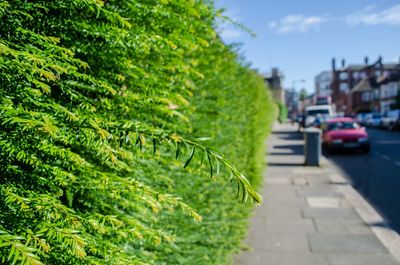Planting Noise Blockers
You should plant noise reducing plants as you would a hedge. Space them so that there won’t be gaps between the plants when they reach maturity. You can even install dense layers of plants to provide optimum noise protection. Begin with a row of shrubs nearest the noise and plant a row of taller shrubs or trees behind them. Finish with a row of showy shrubs that face your home or garden. Choose the inside shrubs for their visual impact, fragrance, fall color, and other desirable features. Consider how the appearance of the shrubs will complement your overall landscape design. For best results, plant noise blocking plants on a berm. Mound the soil as high as possible with a flat top at least 20 feet (3 m.) wide. The ideal height is 3 to 4 feet (around 1 m.) with sides that slope about 10 percent. A combination of a berm and a dense planting can reduce noise by as much as 6 to 15 decibels.
Shrubs and Trees as a Noise Barrier
Evergreen shrubs make the best plants for noise because they provide year-round noise reduction. Broadleaf evergreens are more effective than narrow-leaf plants and conifers. Choose trees and shrubs with dense branches that reach all the way to the ground. Plants, such as hollies and junipers, that have thick branches at ground level provide excellent noise reduction. Additionally, a solid wall is more effective at blocking noise than plants. Combine form and function by using plants along a wall. When the plants don’t reduce noise enough, try adding sounds that mask unpleasant noises. Flowing water is very effective at masking unpleasant noise. A garden fountain or waterfall is well worth the time and expense of installation. Weatherproof speakers allow you to add soothing sounds to the garden too. Many are designed to mimic natural garden features such as rocks.
